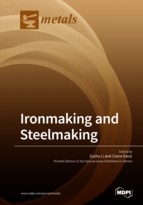Ironmaking and Steelmaking
A special issue of Metals (ISSN 2075-4701). This special issue belongs to the section "Extractive Metallurgy".
Deadline for manuscript submissions: closed (31 December 2018) | Viewed by 138905
Special Issue Editors
Interests: high temperature reactions/phenomena of multi-component systems in metal manufacturing processes; sustainable steel manufacturing technologies; liquid metal processing; steel cleanness; mould powders for continuously casting new steel grades; energy and materials recovery in steelmaking; metal (steel and aluminum) recycling
Special Issues, Collections and Topics in MDPI journals
Interests: development of microstructure during processing from casting to product and the relationships between microstructure and properties (both physical and mechanical) in steels; non-destructive evaluation of microstructure and defects in metals using electromagnetic sensor techniques and modelling approaches
Special Issue Information
Dear Colleagues,
Steel is a critical material in our societies and will remain an important one for a long time into the future. In the last two decades, the world steel industry has gone through drastic changes and this is predicted to continue in the future. The Asian countries (e.g. China, India) have been dominant in the production of steel creating global over-capacity, while the steel industry in the developed countries have made tremendous efforts to reinforce its global leadership in process technology and product development, and remain sustainable and competitive. The global steel industry is also facing various grand challenges in strict environmental regulation, new energy and materials sources, and ever increasing customer requirements for high quality steel products, which has been addressed accordingly by the global iron and steel community.
For this Special Issue, “Ironmaking and Steelmaking”, in Metals, we welcome reviews and articles from the international iron and steel community to cover the state-of-the-art of the ironmaking and steelmaking processes. This includes fundamental understanding, experimental investigation, pilot plant trials, industrial applications and big data utilization in the improvement and optimization of existing processes, and research and development in transformative technologies.
Dr. Zushu Li
Prof. Claire Davis
Guest Editors
Manuscript Submission Information
Manuscripts should be submitted online at www.mdpi.com by registering and logging in to this website. Once you are registered, click here to go to the submission form. Manuscripts can be submitted until the deadline. All submissions that pass pre-check are peer-reviewed. Accepted papers will be published continuously in the journal (as soon as accepted) and will be listed together on the special issue website. Research articles, review articles as well as short communications are invited. For planned papers, a title and short abstract (about 100 words) can be sent to the Editorial Office for announcement on this website.
Submitted manuscripts should not have been published previously, nor be under consideration for publication elsewhere (except conference proceedings papers). All manuscripts are thoroughly refereed through a single-blind peer-review process. A guide for authors and other relevant information for submission of manuscripts is available on the Instructions for Authors page. Metals is an international peer-reviewed open access monthly journal published by MDPI.
Please visit the Instructions for Authors page before submitting a manuscript. The Article Processing Charge (APC) for publication in this open access journal is 2600 CHF (Swiss Francs). Submitted papers should be well formatted and use good English. Authors may use MDPI's English editing service prior to publication or during author revisions.
Keywords
- Ironmaking
- Steelmaking
- Sustainability
- Fundamental understanding
- Process optimization
- Transformative technology
- Industrial application






